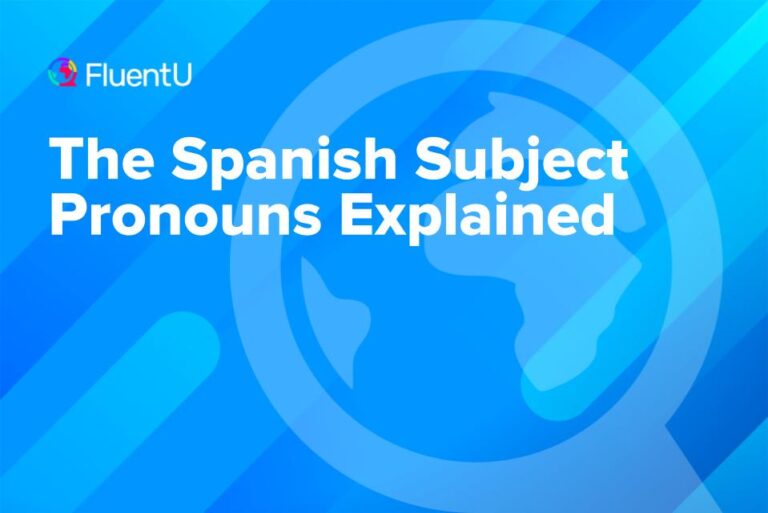Past Participle in Spanish (Forming and Using It)

The past participle is a versatile verb form in Spanish, typically formed by adding -ado or -ido to the verb stem (though there are some irregulars to memorize). From forming perfect tenses to acting as adjectives and even nouns, understanding the past participle is essential for effective communication.
Below I’ll walk you through how to form and use Spanish past participle, with plenty of examples to solidify your understanding.
Download: This blog post is available as a convenient and portable PDF that you can take anywhere. Click here to get a copy. (Download)
What is the Past Participle in Spanish?
The past participle is a verb form that’s typically used with perfect tenses.
Think “I have forgotten,” in English. In this sentence, “have” is the auxiliary verb, or helping verb, and “forgotten” is the past participle of “to forget.”
Spanish past participles work almost the same way. In this case our example translates to “He olvidado,” where “he” (from haber) is the auxiliary verb and “olvidado” (from olvidar) is the past participle.
How to Form the Past Participle in Spanish
To form the past participle in Spanish, all you have to do is drop the ending (-ar, -er or -ir) from the infinitive verb and add –ado or –ido, depending on the verb. –Ar verbs take –ado. –Ir and –er verbs take –ido. Check out the examples below.
| Verb type | Infinitive verb | Past participle |
|---|---|---|
| -ar verbs | acostar
casar tumbar | acostado casado tumbado |
| -er verbs | llover
ser deber | llovido
sido debido |
| -ir verbs | herir
dormir ir | herido
dormido ido |
Irregular Spanish Past Participles
There are a few verbs that don’t follow the above rules:
| Infinitive | Past Participle |
|---|---|
| escribir | escrito |
| romper | roto |
| volver | vuelto |
| hacer | hecho |
| morir | muerto |
There are more irregular past participles, but these are a few of the most common. Sorry, but the only way to learn these irregulars is to memorize them!
Uses of the Past Participle in Spanish
In Perfect Tenses
You’ll most commonly see the past participle used in perfect constructions.
Perfect constructions are used to express that an action began in the past and has continued happening up until the present (or the moment indicated if you’re speaking in the past or the future).
In English, the present perfect would be, “Erin has swum every day this summer.” In Spanish, “Erin ha nadado todos los días este verano.”
Forming the perfect is straightforward; you only have to ever really worry about conjugating one verb: haber. All you have to do is tack on the past participle to your conjugated haber and you’ve got yourself a perfect tense!
| Tense | Example | Meaning |
|---|---|---|
| Present perfect | Erin ha nadado | Erin has swum |
| Past perfect (Pluperfect) | Erin había nadado | Erin had swum |
| Past perfect subjunctive | Erin hubiera nadado | Erin would have swum |
| Future perfect | Erin habrá nadado | Erin will have swum |
Notice a pattern? The past participle never changes. Just use what you know about the verb tenses to conjugate haber and add the past participle.
Check out this article if you want more guidance on the perfect tenses (or any other Spanish tense!).
But now that you know how to form past participles and how to use them with perfect tenses, let’s look at other ways we can use the participle in Spanish.
As an Adjective
The past participle is often used as an adjective. How about that? By learning one word, you’ve really learned two now!
As an adjective, the participle indicates the result of an action or a state of being, much the same as in English.
Notice that the participle as an adjective must agree with the gender (masculine/feminine) and quantity (singular/plural) of the noun to which it refers.
| Use | Explanation | Examples |
|---|---|---|
| Regular use of the participle as an adjective | Use the participle as you would any other adjective and make sure it agrees with the gender and quantity of the noun it's describing. | Rosalba está enfadada.
(Rosabla is upset.) ¡Abre las ventanas! No me gustan las ventanas cerradas. (Open the windows! I don’t like closed windows.) |
| Use of the participle as an adjective independently | Here, the participle is used to make an exclamation, interject or refer to a state of being or situation. | ¿Sorprendido, Ernesto? ¡Soy yo, tu amor perdido!
(Surprised, Ernesto? It is I, your lost love!) El rey, ¿muerto? ¡Dime que no es verdad! (The king, dead? Tell me it’s not true!) ¿Enfadada yo? Eres tú quien está enfadado, Pablo. (Me, mad? You’re the one who’s mad, Pablo.) |
| Use of the participle as an adjective for repeated situations | For these types of situations that happen frequently or repeatedly, use adverbs such as siempre, otra vez or de nuevo. | ¡Siempre cubierto de mugre! ¿Es que vives en un granero?
(Always covered with filth. What, do you live in a barn?) *note that cubrir has an irregular past participle. ¡Dios! ¿Cuántas chicas tiene Luis? Siempre rodeado de ellas. (Geez, how many girls does Luis have? Always surrounded by them.) |
| Use of the participle as an adjective to indicate a temporary relationship between two things | Instead of forming an entire phrase, you can just replace it with the appropriate participle. Sometimes an adverb is necessary to indicate the exact timeline. | Acabada la cena con su marido, María fue a la casa de su amante.
(Dinner with her husband over, Maria went to her lover’s house.) Despedido del trabajo, Fran escribió un libro. (Fired from work, Fran wrote a book.) No puedo ir hasta pasadas las ocho. (I can’t go until after eight o’clock.) Después de empezado el vuelo, no se puede salir del avión. (After the flight has begun, you cannot exit the plane.) |
As a Noun
The past participle in Spanish is also occasionally used as a noun. With a little practice recognizing past participles being used as nouns, you’ll begin to pick up a natural rhythm for what can be used as a noun and what cannot.
A simple way to think about it is that the past participle as a noun often corresponds to the –ed object nouns in English. For example, the painted one (el pintado), the drowned one (el ahogado) or the affected one (el afectado).
Although not all nouns in Spanish are past participles of verbs, a great number are derived from a common root. So by learning the verb, you’re likely learning a noun (or two) anyway. For example, the verb amar could become amado (the loved one) or amante (the lover). Amado is the participle.
Here are some other participles that are used as nouns.
| Infinitive verb | Participle | Meaning |
|---|---|---|
| decir | el dicho | the saying |
| hacer | el hecho | the fact |
| estar | el estado | the state of being |
| herir | el herido | the injured |
| poner | el puesto | the post/position |
| acusar | el acusado | the accused |
| volver | la vuelta | the turn/a walk |
| morir | el muerto | the dead person |
| tostar | la tostada | the toasted sandwich |
With Other Verbs
The participle can be paired up with verbs other than haber to achieve a few more useful effects in Spanish.
| Verb | Explanation | Examples |
|---|---|---|
| With the verb ser | Used to form the passive voice. The participle is in the adjective form and agrees with the noun it describes. | La casa fue destruida por un huracán. (The house was destroyed by a hurricane.) |
| With verbs that express state of being or a result of an action (parecer, quedar(se), estar, mostrar, resultar, etc.) | Again, the participle is used as an adjective and has the same form as the noun. | La mesa está rota.
(The table is broken.) El dibujo resultó mejorado por la lluvia. (The painting was improved by the rain.) |
| With action verbs | The participle can be used as an adverb to indicate how the action is done or the result of an action. It must agree with the subject. | Los perros miran obsesionados a los gatos. (The dogs look obsessed at the cats.)
Carolina nunca llega relajada. (Carolina never arrives relaxed.) |
| With the verb tener | Used to indicate the result of a repeated or extended action. Must agree with the object to which it refers. | Tengo dicho que no salimos los lunes.
(I’ve said repeatedly that we shouldn’t go out on Mondays.) Mi hermana tiene guardado dinero para mi sobrina. (My sister has money saved for my niece.) |
| With the verb dejar | Used to indicate that the action has been completed earlier as a precaution. Must agree with the object to which it refers. | Mi madre nos dejó hecha la cena. (My mother left us dinner already made.) |
| With the verb llevar | Used to indicate the accumulation of a continuous action. Must agree with the object to which it refers. | Josh ya lleva gastados 1000 euros este mes. (Josh has already spent 1,000 euros this month.) |
The Past Participle Versus the Gerund
So I know that by now it seems like you can use the past participle for pretty much anything. While it has many uses, there are a few things you cannot use it for.
It’s generally not used as an adverb (except when it is; see above). Instead, use the gerund. Or, if you want to get real fancy, you can use the two together in various ways, as shown below.
| Use | Example | Meaning |
|---|---|---|
| Perfect tense + gerund as an adverb | He ido corriendo al mercado. | I have run to the market. |
| The perfect participle | Habiendo entrado, fui directo al baño. | Having entered, I went straight to the bathroom. |
| Perfect progressive tenses | Sven ha estado bailando toda la noche. | Sven has been dancing all night. |
The Past Participle Versus the Infinitive
Most of the time, the past participle is also not used as a noun (except when it is; see above). Instead, use the infinitive.
| Use | Examples | Meaning | ||
|---|---|---|---|---|
| Use the infinitive as a noun | Ganar es mejor que perder. | Winning is better than losing. | ||
| Make the perfect infinitive by using haber with the participle | Haber vivido en los años treinta habría sido muy difícil. | To have lived in the thirties would have been very difficult. | ||
| Use deber followed by the perfect infinitive to express probability in past time (instead of using subjunctive and conditionals) | Deben haber perdido los juguetes.
Debe haber tomado el gorro. | They must have lost the toys. He must have taken the hat. |
Resources for Past Participle Practice
Look at your past participle boss-ness. You can sling a past participle with the best of them now. But just to make sure, here are a couple resources that you can use to practice.
- Barbara Kuczun Nelson’s page at Colby University is one of my favorite websites for learning Spanish. Check out her lesson with the song “¿Dónde jugarán los niños?”
- Check out the site Hola Qué Pasa for some practice exercises and the Spanish Learning Lab for more examples with audio by native speakers.
- Authentic Spanish media made for and by native speakers can also show past participles in real contexts. You can check out Spanish books, TV shows and movies. There are also the bite-sized videos on the language learning program FluentU.
FluentU takes authentic videos—like music videos, movie trailers, news and inspiring talks—and turns them into personalized language learning lessons.
You can try FluentU for free for 2 weeks. Check out the website or download the iOS app or Android app.
P.S. If you decide to sign up now, you can take advantage of our current sale!

The important thing is to just keep practicing, and soon you won’t even give participles a second thought.
Download: This blog post is available as a convenient and portable PDF that you can take anywhere. Click here to get a copy. (Download)
And One More Thing…
If you've made it this far that means you probably enjoy learning Spanish with engaging material and will then love FluentU.
Other sites use scripted content. FluentU uses a natural approach that helps you ease into the Spanish language and culture over time. You’ll learn Spanish as it’s actually spoken by real people.
FluentU has a wide variety of videos, as you can see here:

FluentU brings native videos within reach with interactive transcripts. You can tap on any word to look it up instantly. Every definition has examples that have been written to help you understand how the word is used. If you see an interesting word you don’t know, you can add it to a vocab list.

Review a complete interactive transcript under the Dialogue tab, and find words and phrases listed under Vocab.

Learn all the vocabulary in any video with FluentU’s robust learning engine. Swipe left or right to see more examples of the word you’re on.

The best part is that FluentU keeps track of the vocabulary that you’re learning, and gives you extra practice with difficult words. It'll even remind you when it’s time to review what you’ve learned. Every learner has a truly personalized experience, even if they’re learning with the same video.
Start using the FluentU website on your computer or tablet or, better yet, download the FluentU app from the iTunes or Google Play store. Click here to take advantage of our current sale! (Expires at the end of this month.)








